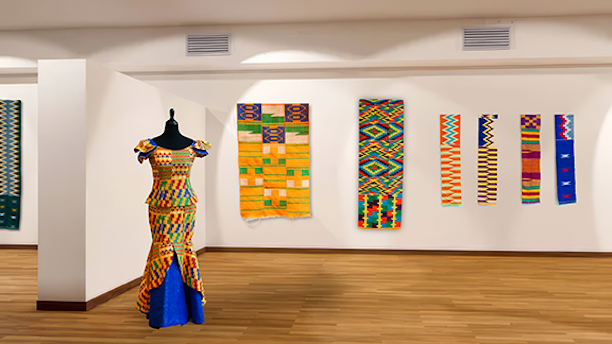The Meaning Behind Kente: Dr. Gifty Afua Benson Explores the Legacy of Ghana’s Sacred Cloth

Kente cloth is recognized worldwide by its bright colors and rows of bold, woven patterns. It is an unmistakable showcase of Ghana’s master weavers. With historical roots dating back hundreds of years—and deep meaning connected to each distinct pattern—there is much more to kente than meets the eye.
ExhibitsUSA is excited to be creating The Legend of Kente touring exhibition in collaboration with curator and collector Dr. Gifty Afua Benson. The exhibition includes over 50 kente weavings, four dresses, and an illustrative “making kente” video, along with interpretive materials that explore the meanings, symbols, and stories depicted by the weavers.
Below, you’ll learn about the incredible history and significance of this beautiful tradition.
Can you share some insights into the history and cultural significance of Kente cloth in Ghanaian and African heritage?
Dr. Benson: Kente is the national cloth of Ghana, West Africa—our national pride and joy. Handwoven by Ghana’s master weavers, its bright colors and bold patterns make it the most recognizable cloth in the world.
It has been said that Kente originated in the village of Bonwire, now the kente center of Ghana, and was inspired by a spider’s web. Historically a royal cloth, kente has now gained immense cultural significance, and has become a national and global icon and a symbol of the Black Diaspora.
Each kente has a name, a meaning, and a story to tell. The color black can represent spiritual energy and union with ancestors, while green often represents renewal and growth. Kente designs are powerful cultural symbols that can be used as a non-verbal way of communication, with each of the hundreds of patterns having its own name. For instance, the pattern named “Mako Maso Adeae” translates to “my heart’s desire,” proclaiming love akin to gifting heart-shaped jewelry.
Can you tell us the story of one of the pieces / artifacts in the exhibition?
Dr. Benson: “Fathia” is one of the pieces in the exhibition, and it has many names and versions. Fathia was commissioned and specially woven by a group of master weavers from Bonwire for Fathia Nkrumah, the Egyptian-born First Lady of Ghana and wife of Kwame Nkrumah, the first President of Ghana, 1957.
“Fathia” is a classic with an intricate design. It is one of the most expensive and most popular and most beautiful kente of all times. The three principal designs in Fathia are Zigzag (Nkyinkyim), nine squares representing nine Haircuts (Mpuaa), and Thunder (Apremoo). There can be many permutations of these three designs in different versions of “Fathia.”
After the overthrow of the Nkrumah government in 1966, two new names of “Fathia” were coined: “One head does not form a committee” and “One man cannot rule a nation alone.” In the kente weaving center of Bonwire, it is simply referred to as “Fathia.” It is the most widely sold Kente.
For those who want to learn more about Kente or support artisans, what books do you recommend?
Dr. Benson: I have many recommendations for additional reading, which—subject to availability—are included in accompanying materials for venues hosting the exhibition. Some suggestions for adults are E. Asamoa-Yaw’s Kente Cloth: History and Culture, Matchstick Literary, 2019, and Doran H. Ross’s Wrapped in Pride: Ghanaian Kente and African American Identity, UCLA Press, 1998.
For children, I recommend Margaret Musgrove and Bat Favistou Boulandi’s The Spider Weaver: A Legend of Kente Cloth, Apprentice House, 2015, and Juwanda G. Ford’s A Kente Dress for Kenya, Scholastic Incorporated, 1996.
EUSA works with small and mid-sized galleries across the US, rural and urban areas. How did EUSA help this exhibition come to life and how did the partnership with EUSA inform the exhibition?
Dr. Benson: This is my second time partnering with ExhibitsUSA. Our first partnership, Wandering Spirit: African Wax Prints, was so good that we wanted to continue working together. Wandering Spirit: African Wax Prints was an exhibition that toured with ExhibitsUSA from 2016 to 2021. It traced the developmental pathway of handmade designs and patterns on wax-resist dyed textiles that originated in Indonesia before being industrialized by Europeans and exported to Africa.
What else is important for people to know about this exhibition and/or your work?
Dr. Benson: Kente speaks to us. There is a story in each cloth. It continues to inspire me every day.
The Legend of Kente is touring June 2026 through May 2031.
Please contact MoreArt@maaa.org or (800) 473-3872 x208/209 for current availability and information about booking this touring exhibition for your venue.
Learn more about M-AAA’s touring exhibition program, ExhibitsUSA.
Header image: Digital installation mockup with peplum and long skirt featuring the Obaa Pa (Good Woman) motif in the foreground and various Kente motifs in the background, 2023. Courtesy of Beatrice Benson Collection.